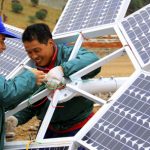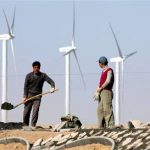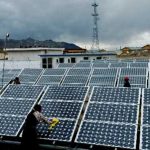Green China, pt. 3: Renewables (可再生能源) Posted by Stephen on Nov 17, 2010 in Uncategorized
 Going green is no small task if you want to do it profitably in this specialized, global economy. For nearly a half century, scientists have voiced their concerns of arable land/food shortages, the decline of petroleum and coal reserves and loss of clean water resources (via CO2 green house gas production), but were dismissed as economically inviable due to lack of industry growth and advancements to technology. China, who officially entered the industrial scene in the 1970’s, was playing catch up with the rest of the world, and in an effort to catch up, relied upon some of the most waste creating and polluting sources of development. Unfortunately for China, cramming centuries of GDP growth and industrialization into a mere three decades came at a debilitating cost to the environment.
Going green is no small task if you want to do it profitably in this specialized, global economy. For nearly a half century, scientists have voiced their concerns of arable land/food shortages, the decline of petroleum and coal reserves and loss of clean water resources (via CO2 green house gas production), but were dismissed as economically inviable due to lack of industry growth and advancements to technology. China, who officially entered the industrial scene in the 1970’s, was playing catch up with the rest of the world, and in an effort to catch up, relied upon some of the most waste creating and polluting sources of development. Unfortunately for China, cramming centuries of GDP growth and industrialization into a mere three decades came at a debilitating cost to the environment.
Realizing this, the Chinese government has recently made sustainable growth and clean development a top priority, seeking profitability in the fledgling industries of renewable energy or 可再生能源 (kě zài shēng néng yuán). More so, China isn’t just entering renewable energies markets–they’re cornering them. And soon China will become an industry leader in just about everything relating to renewable energy technologies. Oh the benefits of an centralized government that dictates policy efficiently and effectively. I’m just saying…
Currently, China is the industry leader in both wind power (turbines) and solar panels. China is also actively pursuing hydro-electric energy as a large source of domestic energy power (including security). Let’s take a look at how China got there, and the future of these renewable industries as the Green Dragon surges forward.
 By the end of 2009, China’s wind capacity had passed 25 GW (gigawatts), cementing it as a global leader in clean, green, wind power. China, much like the United States, benefits from a vast area of land mass with many different unique geographical features, including the great expanse of the northern plateau, Mongolia and the Gobi dessert. While wind turbines or 风力涡轮机 (fēng lì wō lún jī) and large windmills cannot fit within already crowded Chinese cities and metropolises, these remote and sparsely populated areas of China are perfect locations for developing wind turbine arrays that power neighboring cities and provinces. Further, the lack of substantive vegetation, coupled with the wide open spaces of desert land, creates super windy conditions that fluctuate with the rise and setting of the sun.
By the end of 2009, China’s wind capacity had passed 25 GW (gigawatts), cementing it as a global leader in clean, green, wind power. China, much like the United States, benefits from a vast area of land mass with many different unique geographical features, including the great expanse of the northern plateau, Mongolia and the Gobi dessert. While wind turbines or 风力涡轮机 (fēng lì wō lún jī) and large windmills cannot fit within already crowded Chinese cities and metropolises, these remote and sparsely populated areas of China are perfect locations for developing wind turbine arrays that power neighboring cities and provinces. Further, the lack of substantive vegetation, coupled with the wide open spaces of desert land, creates super windy conditions that fluctuate with the rise and setting of the sun.
The National People’s Congress (legislative branch of the Chinese government) permanent committee passed a law that requires the Chinese energy companies to purchase all the electricity produced by the renewable energy sector, including newly established wind power plants. While coal is still much cheaper than its wind power counterpart, the Chinese government is actively pursuing subsidization policies to help vertically integrate this industry into its energy network, lowering costs and long-term making wind power viable. Because wind power is considered “supplementary” to baseline wattage of coal fired electricity, it acts as a growing compliment to the power grid that lowers reliance on coal powered electricity over the long-term.
The current leading wind power companies in China are Goldwind, Dongfang Electric, and Sinovel.
Solar Power or 太阳能 (tàiyáng néng)
 China is also leading the solar power charge and looks to be the main exporter of solar technology in years to come. While already leading in manufacturing of photovoltaic panels or 太阳帆板 (tàiyángfānbǎn), China has for decades resorted to solar-thermal water heaters in many southern and western locales. Currently, China has over 400 photovoltaic (PV) companies and produces approximately 23% of the photovoltaic products worldwide. That trend is quickly rising.
China is also leading the solar power charge and looks to be the main exporter of solar technology in years to come. While already leading in manufacturing of photovoltaic panels or 太阳帆板 (tàiyángfānbǎn), China has for decades resorted to solar-thermal water heaters in many southern and western locales. Currently, China has over 400 photovoltaic (PV) companies and produces approximately 23% of the photovoltaic products worldwide. That trend is quickly rising.
A big reason why China has been able to dominate this industry is due in large part to the low-cost, high-tech, manufacturing industry of China that receives subsidization and promotes innovation. This is because the basic principle of increasing PV efficiency per panel is thus: finer etching of smaller and smaller cells within a caustic silicone setting. China, which holds a disproportionate amount of rare earths (including lanthanides) which are being incorporated in Silicon solar arrays, benefits not only from abundance of natural resources perfectly suited for both the wind and solar industry, but also benefits from a highly-specialized workforce that is given the capital and research grants to constantly innovate and stay ahead of the curve. Comparative advantage, thy name is China.
http://www.youtube.com/watch?v=8LxM2skgfQo
China is also the world leader in solar thermal energies, including the use of solar thermal water heaters or 太阳能热水 (tài yáng néng rè shuǐ qì) which are found throughout southern and western China. Where photovoltaics are expense and require maintenance upkeep costs, solar thermal heaters are cheap, easy to use/fix and just make plain sense in areas where sunlight is abundant.
Hydro-Electric power or 水电力 (shuǐ diàn lì)
Lastly, China has turned to hydro-electric power to help mitigate the pollution caused by coal plants. They do so by creating dams or 水坝 (shuǐbà), either artificially or naturally, and bottleneck the their water supplies into great turbines. The most notable dam (you guessed it) is the Three Gorges Dam or 三峡大坝 (Sān xiá Dà bà) which is the world largest electricity producing dam, spanning the Yangse River in Hubei province.
http://www.youtube.com/watch?v=FSsKSNcA-uM
The dam body was completed in 2006. The originally planned components of the project were completed on October 30, 2008, with 26 generators in commercial operation. Each generator has a capacity of 700 Megawatts (MW). Six additional generators in the underground power plant are not expected to become fully operational until 2011. Coupling the dam’s thirty-two main generators with two smaller generators (50 MW each) to power the plant itself, the total electric generating capacity of the dam will eventually reach 22.5 GW.
While many environmentalist and human rights activists are unhappy with flooding a huge (and populated) natural basin in order to channel so much force, the damn does provide a large amount of power at a relatively clean cost to the environment. However, with China’s quickly diminishing water sources, expect less of an emphasis on large dam projects, and a greater focus on solar, wind and other renewable sources of energy.

Build vocabulary, practice pronunciation, and more with Transparent Language Online. Available anytime, anywhere, on any device.
About the Author: Stephen
Writer and blogger for all things China related. Follow me on twitter: @seeitbelieveit -- My Background: Fluent Mandarin speaker with 3+ years working, living, studying and teaching throughout the mainland. Student of Kung Fu and avid photographer and documentarian.




Leave a comment: